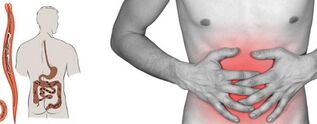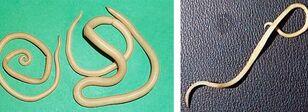
As you know, parasites are considered the most resistant organisms to the environment. To date, about 250 species have been recognized as helminths capable of infecting humans. All of them pose a threat to the health and, in more severe cases, to the lives of those infected. Knowledge of helminth species in humans and their characteristics greatly facilitates treatment and helps to draw up an effective prevention plan.
What worms do humans have?
It takes a long time to fully understand the types of worms. The fact is that so far scientists have not been able to provide the most detailed information on the classification of parasites. This is largely due to the fact that a certain area is characterized by the presence of specific helminthic invasions. In this regard, it is almost impossible to obtain data on all types of human helminths existing on Earth.
Thus, the worms most commonly diagnosed in the southern zone are virtually non-existent in the population of the northern geographical regions. For the temperate climate zone and the average latitudes, about 20 species of worms are recognized as the most common. They can be conditionally divided into 3 main categories:
- Round parasitic worms (nematodes).
- Paste helminths (cestodes).
- Flatworms (trematodes).
1. Round and flat helminths
Each of the above groups includes a huge variety of parasitic organisms that require a brief description. In children and adults it is most often necessary to treat such representatives of worms belonging to the class of trematodes:
- Chinese methyl;
- feline methyl;
- hepatic fluke.
Among the nematodes, there are 7 of the most famous and common parasitic species that inhabit the body at any age. The roundworms that are transmitted in every possible way are:
- blades;
- roundworm;
- intestinal acne;
- whip;
- Trichinella;
- trichostrongylides;
- hookworm.
2. Invasions of cestodes
Tapeworms (or cestodes) are parasitic worms that pose the greatest threat to the body. Diagnosis of such worm infestations occurs much less frequently than roundworm infections in children and adults, but infection with the following types of worms is fraught with the most serious consequences:
- bull tapeworm;
- dwarf tapeworm;
- swine tapeworm;
- wide bar;
- echinococcus; rat tapeworm.
One of the rarest types of helminth infestations is acanthocephalus. These include the giant ridge and the bead ridge. Such worms are able to enter the body in the rarest cases, for example, when they eat an insect or its larva infected with parasites.
Why are worms dangerous to humans?
In order to adequately assess the degree of threat to the patient's health in the case of helminth colonization, it is first necessary to determine to which species of worms they belong. Depending on the type of worm, its treatment and duration are determined. The main damage from the presence of parasites in the body is felt by the intestines - the vast majority of all helminths are localized in this organ. All the nutrients that need to be assimilated and are beneficial to humans are selected by worms.
Meanwhile, other types of worms don't just settle in the gut and "steal" all the necessary valuable micronutrients from humans. They multiply actively and affect other vital human organs and systems. In addition to the heart muscle, liver and lungs, worms can cause enormous damage to the brain and blood vessels. Worms can even infect the eyes.
Basic ways to infect with worms

You can protect yourself and your loved ones from the onset of the disease if you know how helminths of a certain species enter the body. This is the only way to take all the necessary measures in a timely manner and to minimize the risk of infection. The main transmission paths are known to be:
- Infection occurs through soil and water. When walking on the ground barefoot, the risk of laying eggs inside increases several times. An untested source of drinking and in common cases even tap water may contain worm larvae.
- Helminth eggs enter the body along with animal products. The result of helminth infestations is insufficient or poor processing of meat, fish, seafood, eggs. People who prefer exotic Asian cuisine are at risk of worm infestation. He, sushi, sashimi are based on raw fish and meat.
- Some types of parasites can settle in the gut, getting into it along with unwashed vegetables and fruits. Withdrawal of animal products does not solve the problem of the likelihood of developing helminthiasis. Worm eggs, as already mentioned, can be contained in the soil. It is recommended to pour boiling water over the fruit before use.
- Worms are transmitted to humans and animals. Pets do not often become a source of infection for their owners. However, worms can be found both inside the animal and in its fur. From dogs and cats, the eggs of the parasites fall into the soil and spread further with molten water.
Transmission of parasites by sick people
Worms can also move from one infected person to another. There are several ways to transmit helminth infestations:
- through unwashed hands (for example, when shaking hands, hugging);
- when using common utensils;
- when you wear someone else's underwear;
- group application of personal care products by several people.
Worm eggs most often pass from person to person, often falling under the nail plates, staying there for a long time. The predominance of this type of worm in children is explained by the neglect of the basic rules of cleanliness. A child can simply pull his hands into his mouth or bite his nails so that the blades have no difficulty in penetrating a new human body. The task of parents at this stage is to recognize the signs of helminthiasis in a timely manner and to prevent the development of helminthic infestations in their baby, immediately starting to treat the disease.
Symptoms of the acute stage of helminthiasis
It is not easy to detect early signs of a parasitic infection in an adult or child. The diagnosis of the presence of worms is complicated by the fact that the incubation period in some species can last up to a year and a half.
As a rule, the first symptoms of worm infection appear after different periods. In addition, the course of helminthiasis can be conditionally divided into 2 stages:

- acute stage (lasts on average no more than two months after the incubation period);
- chronic (characterized by the development of sexually mature parasites and can last for decades).
In the acute phase of invasion, the main, pronounced symptom may be called an allergic reaction. As a result of the production of antibodies during the migration of parasitic larvae, pathological manifestations on the skin should be warned. Indicators of infection with any type of worm in humans are the following symptoms:
- hyperemia of the skin;
- burning and itching sensation;
- small rashes on the surface of the epidermis or mucous membranes;
- slight enlargement of the lymph nodes;
- local edema;
- sternum pain (up to suffocation attacks);
- vomiting and constant nausea;
- diarrhea or constipation.
In addition, such dangerous pathologies as pneumonia, meningoencephalitis, hepatitis can become complications from the appearance in the body of other creatures.
A reliable confirmation of the presence of helminths in the internal organs is the eosinophil index in the clinical blood test. The increased value of these particles is caused by dysproteinemia - a violation of the normal numerical ratio between protein fractions.
Types of symptoms in chronic form of the disease
The signs of chronic helminthiasis in humans are predetermined by the location of the parasite colonization. In simple words: the manifestations of the disease will depend on which organ will become the main habitat for a particular type of worm.
In particular, the most common parasitism in the intestines of roundworms can occur without the slightest symptoms. If larger species are affected by worms, the signs of the disease will become noticeable as soon as the worms reach puberty. Dyspeptic disorders in adults and children, pain syndrome and neurotic manifestations are their characteristic features. Ascariasis is often characterized by the development of intestinal obstruction and pancreatitis, and the risk of cancer increases.
Parasite medications
You need to be treated for helminthiasis as early as possible. An effective therapy will be if before you start, you know exactly what type of parasite has settled in the body. There are many anthelmintic drugs available today.
These are different types of drugs that can target a specific type of worm. Stronger anthelmintics are broad-spectrum drugs and are excellent for treating combined helminthiasis. Both are considered toxic, have many side effects and contraindications. The use of such drugs should be done with extreme caution only after a medical recommendation.
Most types of worms in adults take a long and difficult time. Parasitologists often prescribe several anthelmintic drugs at the same time.
The regimen and dosage of a particular drug should be prepared exclusively by a specialist. This will help avoid allergies and serious side effects. For some types of helminth infection, treatment must be repeated. This is often due to the fact that during the first therapy most adult worms were neutralized, but some forms of larvae and helminth eggs still remain in the patient's body. If left untreated, the worms will return.
Basic prevention measures
Drug therapy is undoubtedly an important part of the process of eliminating and in some cases preventing parasites. However, to deal with invasive worms, you need to follow the simplest rules to prevent worms. The treatment will not work if you ignore the following rules:
- Wash your hands often, especially after going to the toilet and before eating.
- If it is not possible to clean the skin of your hands with soap, it is recommended to use wet antibacterial wipes.
- Any food should be rinsed thoroughly before cooking.
- It is important to expose meat and fish to prolonged heat exposure.
- Use only water from reliable sources for drinking.
- At least once a year, it is extremely important to get tested for worms.
















































